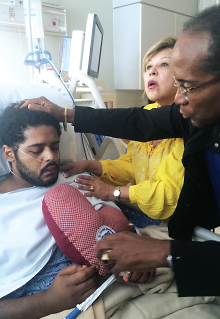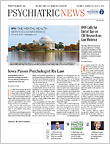A year ago in August, Alan Pean, a 26-year-old who has bipolar disorder, was shocked with a Taser and shot in a Houston hospital after driving himself there for treatment.
According to a report that appeared in the New York Times on February 12, Pean had sought care at the emergency department of St. Joseph Medical Center in Houston. He was admitted to the hospital and later became increasingly delusional while waiting overnight for treatment. At some point, nurses called security, and before the night was over, Alan was shocked with a Taser and shot in the chest by off-duty police officers.
Alan recovered, and today he is speaking out about what happened to him. He told the Times, “I thought of the hospital as a beacon, a safe haven. I can’t quite believe that I ended up shot.’ ”
Last month Alan’s brother, Christian Pean, M.D., an orthopaedic surgery resident at NYU Hospital for Joint Diseases, brought the issue to the annual policymaking meeting of the AMA House of Delegates. That led to the delegates’ approving a resolution—originally drafted by Pean and colleagues with the AMA Minority Affairs Section and supported by the AMA Section Council on Psychiatry—that advocates “that hospitals and other health care delivery settings limit guns and conducted electrical weapons [commonly known as Tasers] in units where patients suffering from mental illness are present.”
“We brought this resolution to the AMA because it speaks to the different issues my brother’s shooting raises about the safety of patients with mental illness in the hospital and other health care settings,” Pean told Psychiatric News.
He said the use of firearms and Tasers on patients is becoming more common in American health care settings, one that disproportionately affects people with mental illness and, especially, racial and ethnic minority patients with mental illness.
According to the Times, “More and more American hospitals are arming guards with guns and Tasers, setting off a fierce debate among health care officials about whether such steps—along with greater reliance on law enforcement or military veterans—improve safety or endanger patients.”
The Times added, “The same day Mr. Pean was shot, a patient with mental health problems was shot by an off-duty police officer working security at a hospital in Garfield Heights, Ohio. Last January, a hospital security officer shot a patient with bipolar illness in Lynchburg, Va. Two psychiatric patients died, one in Utah, another in Ohio, after guards repeatedly shocked them with Tasers.”
In reference committee hearings prior to the meeting of the House of Delegates, the resolution was widely—and in some cases, passionately—supported. The resolution was also supported by the Section Council on Psychiatry.
“I applaud Dr. Pean for bringing this issue forward to the AMA. His action has both established new policy and helped increase awareness about the dangers associated with the presence of firearms and Tasers on inpatient psychiatric units,” said David Fassler, M.D., alternate delegate to the AMA from the American Academy of Child and Adolescent Psychiatry. “Hopefully, the involvement of the AMA will lead to enhanced safety for both patients and staff.”
Some physicians expressed that the safety of patients, physicians, and staff at hospitals sometimes depends on the use of force by security personnel; language in the original resolution that called for “restricting” firearms and Tasers was modified to “limited.” Existing AMA policy was also reaffirmed in place of several other items in the resolution—those addressing advocacy for patients with mental illness, reporting of “sentinel events” in the hospital, and training of personnel in the “de-escalation” of potentially violent encounters.
“We are happy with the revised resolution and believe that its being adopted is an important step to address the issues it brought up,” Pean told Psychiatric News. “The reaffirmation of policies that speak to some of the other concerns in the resolution is also positive, and we hope to build on this policy in the future.”
Pean said he believes events such as what happened to his brother Alan “send a message of fear to patients and may be a serious deterrent to seeking mental health treatment if they think there is a possibility of being shot. It’s important to remember that my brother willingly sought out health care services at the hospital.”
Pean’s involvement with the AMA began last year when he won an “Excellence in Medicine” award from the AMA Foundation. (Every year the AMA Foundation recognizes several physicians with this award, including residents and medical students who have demonstrated excellence in “advocacy, community service, public health, or education.”) After that, he stayed in contact with other young physicians in the AMA. “I became involved with the Minority Affairs Section because the section is passionate about advocating for many of the same things I am passionate about,” he said.
“After my brother’s encounter, I started to talk to people about what kinds of effort could be made to reverse this trend,” Pean said. “I decided that the AMA is the premier medical society and that it should address this problem.”
Pean worked with psychiatrist Dionne Hart, M.D., to craft the language of the resolution and to gather support from psychiatrists and physicians in other specialties.
In the meantime, Alan Pean has been doing his own advocacy and has travelled to Yale University School of Medicine and Harvard Law School to talk about his experience.
“My brother felt it was imperative to speak about his mental illness and what happened to him,” Pean told Psychiatric News. ■
The Times article on the shooting of Alan Pean can be accessed
here.


